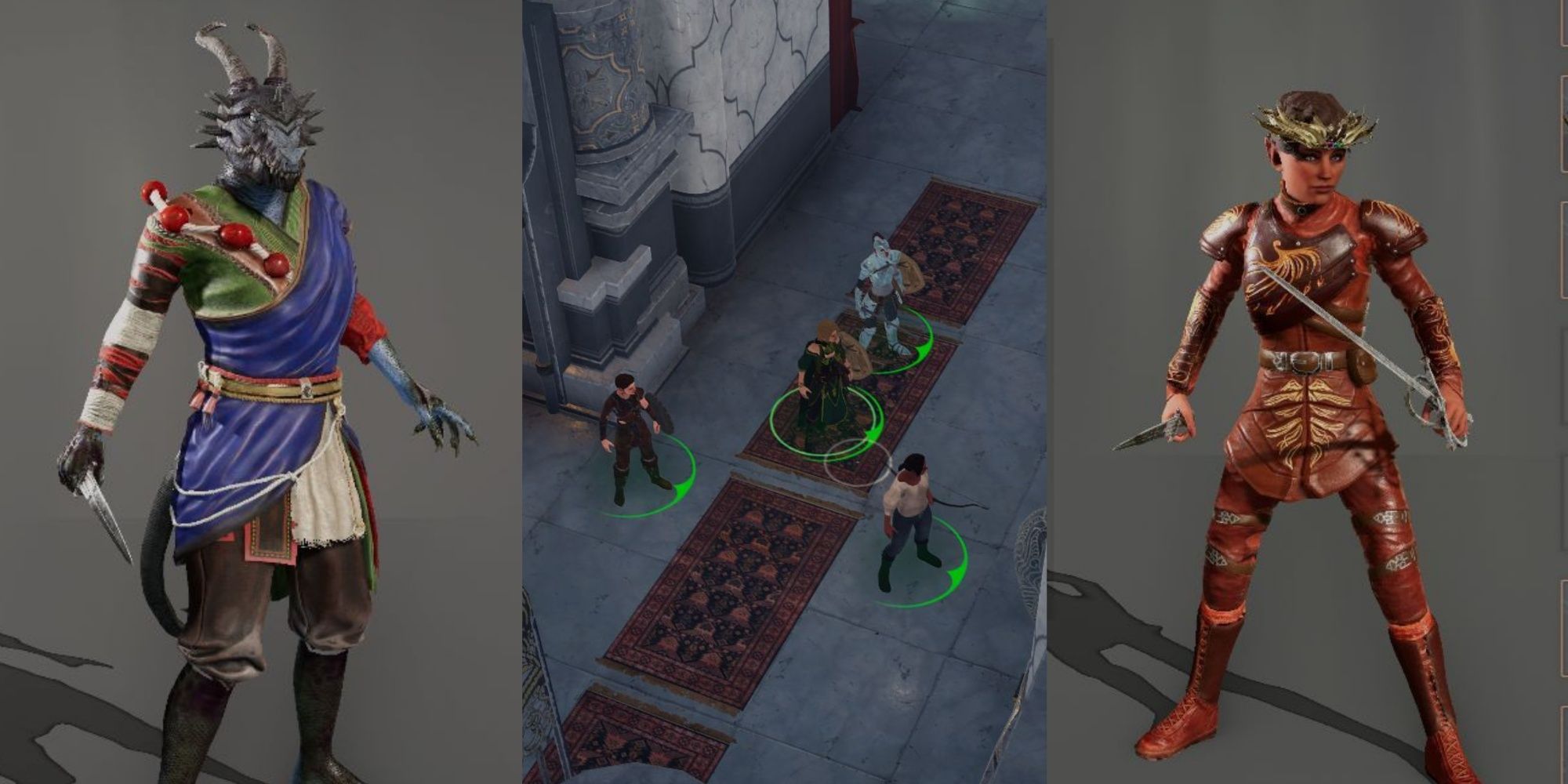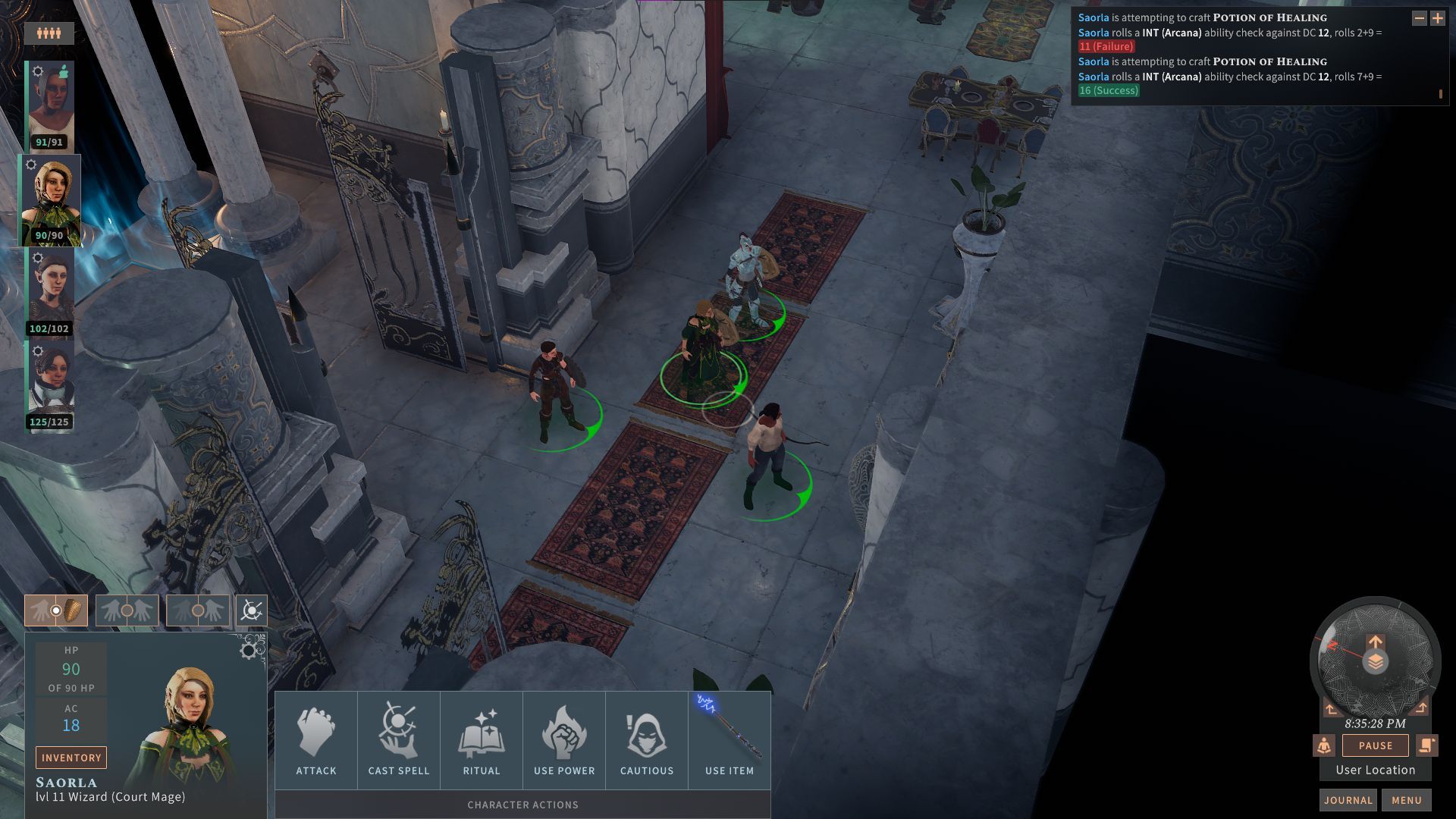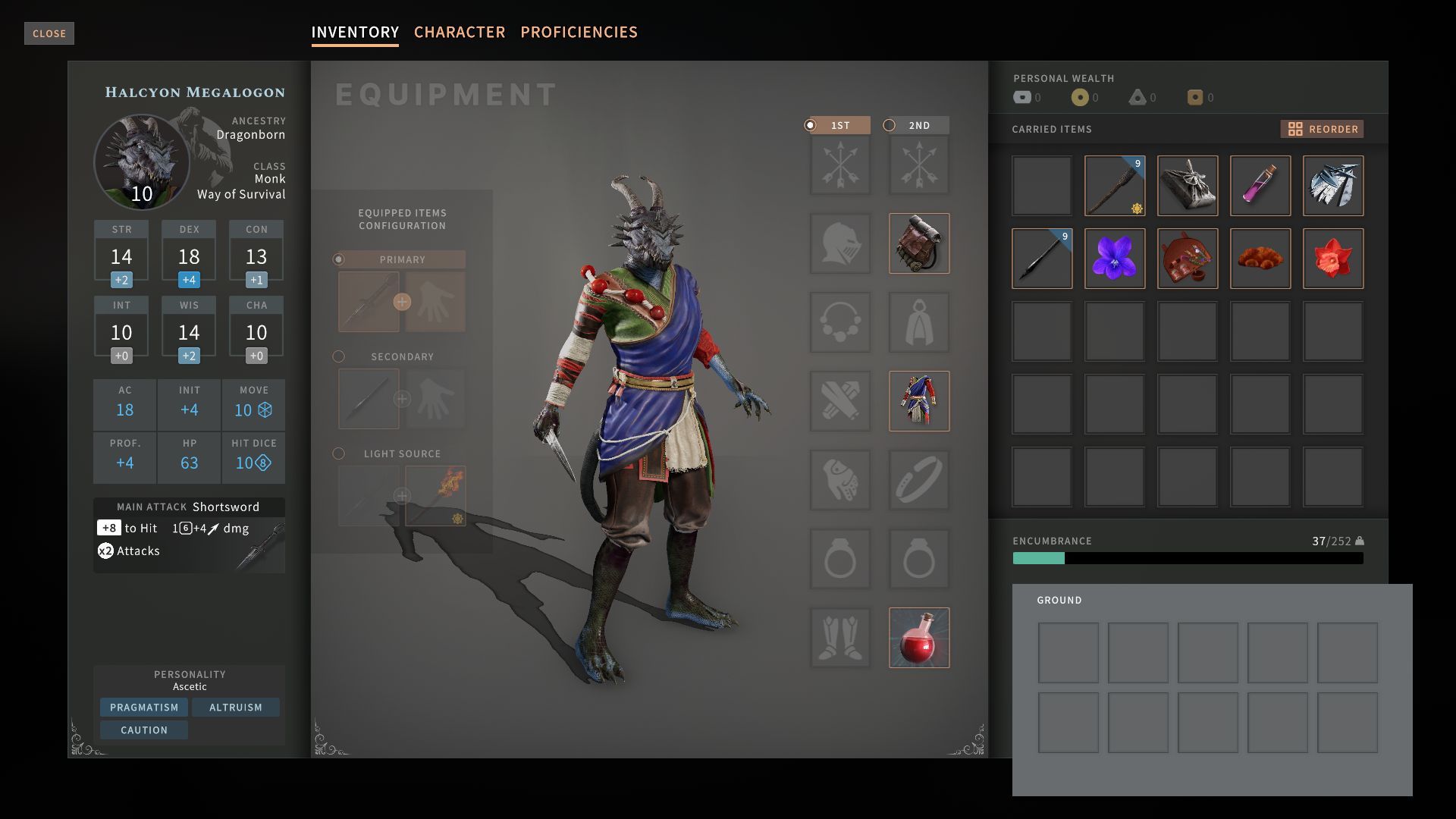Quick Links
Solasta: Crown of the Magister has the blood of fifth edition DnD running through its veins but takes several of the classes in new directions that better make use of its position as a video game. You'll want to plan your team and character builds accordingly.
Synergies between the classes will matter far more in your four-person band than individual abilities. A single player controlling all four adventurers can make strategic decisions that aren't as viable or fun in a normal Dungeons & Dragons game such as building an entire party to complement a single character's abilities.
Certain builds that are staples of fifth edition DnD (polearm master being a significant one) have no equivalent in Solasta while others have new options opened by the game's unique subclasses.
Sneak-Attack-Focused Party
Class | Application |
|---|---|
Rogue | The linchpin of this team composition is the two rogues. Sneak attacks offer a powerful boost in damage and having full control of the party allows you to make use of positioning and buff spells to activate it with incredible consistency. |
Hoodlum Rogue | Using the new hoodlum subclass can allow one of the rogues to wear medium armour and sneak attack with non-finesse weapons. This can keep the two characters from overlapping in the equipment they need and skills they cover. |
War Cleric | A war cleric can join the front lines, soaking damage and providing flanks for the rogues to leverage. Being in the front lines allows them to make the best use of spells like Spirit Guardians, providing some much-needed Area Damage. This is the character most likely to be targeted by enemy attacks so provide them with your strongest defensive gear, which should also reduce how often he needs to make concentration checks. |
Sorcerer | The sorcerer will gain powerful buff spells such as haste and greater invisibility that can be further empowered with metamagic, twin casting it to affect both rogues at once. Against weaker enemies, haste offers greater utility, providing more attacks per turn as well as movement to maneuver between them. Against stronger fights, greater invisibility offers supreme amounts of defence and provides advantage on all attacks. In both cases, you'll want this caster to keep as far from the combat as possible to avoid concentration-breaking effects. |
Be careful with twin casting haste. If you lose concentration or the duration expires, the whiplash from the spell ending will stun both rogues for a turn.
Having two rogues means that expertise proficiencies can be applied to all the most important crafting tools and skill checks, and that they can scout ahead without being entirely alone if discovered.
The weak point of this team is the limited availability of utility casting. A sorcerer does not learn enough spells to pick up utility options like detect magic or identify, while the cleric will be too focused on keeping everyone alive to spare spell slots outside ritual casting.
Ritual casting can still cover some of the main utility areas, but a cleric will need to have the spells prepared before ritual casting them.
A War Cleric is also able to cast haste, meaning that, instead of a twin casting sorcerer, you could bring a spellcaster with stronger utility coverage, such as a wizard.
Turtle Formation Party
Class | Application |
|---|---|
Barbarian Of Stone | The barbarian of stone is able to endure an incredible amount of damage with the temporary HP they generate each turn while raging. This allows them to tie up enemies in melee very effectively. |
Court Mage Wizard | The court wizard is able to use their reaction to protect adjacent allies. Standing in the middle of a formation, they can impose disadvantage on any snipers trying to pick off the squishy archers behind them or heavy hitters that could bulldoze the barbarian in front of them. They can also provide a powerful shield to an ally that provides temporary HP. Temporary HP is wasted on the Stone Barbarian, who generates their own, but can allow the rogue to dive into melee more readily as needed. |
Thief Rogue | Without a dedicated healer, you may want to double up on potion crafting proficiencies and spread healing potions evenly between party members for emergency use. The Thief Rogue can use their Fast Hands ability to feed people potions as a bonus action. This keeps their main action available for performing sneak attacks, preferably using a bow from behind the court wizard. They won't be able to use their cunning action to hide after using Fast Hands, so you'll want to prioritise targets that you can activate sneak attack on in other ways. |
Ranger | The ranger acts as another source of both healing and ranged damage while not quite matching the efficiency of a dedicated cleric or rogue. When potions aren't available they can keep the thief supplied with Goodberries that heal one HP each. |
You could substitute the stone barbarian for a heavily armoured fighter, complementing the Court Mage's defensive style with a higher Armor Class.
This team makes use of positioning to maximise the survivability of its two back-line characters, the rogue and ranger.
The weak point of this team is enemies that either break up the formation or pummel you with area-of-effect attacks. Be willing to adjust your strategy against enemies that seem likely to do either, such as dragons.
Ambushes will also start you out of formation, so invest well into perception and avoid traveling at a fast pace.
The Snoozelocks, Featuring Way Of Survival Monk
Class | Application |
|---|---|
Warlock Of The Hive | This warlock specialises in combating other spellcasters. Their subclass features allow them to resist magical effects and strip opponents of their own magical defences. Weakening pheromones forces the enemy they damage to make their next saving throw at disadvantage. This can set up the monk to make a Stunning Strike or enable the other warlocks to inflict a powerful debuff. |
Warlock Of The Timekeeper | The most abstract of the new warlock patrons, this one is focused on dealing damage over time, and that makes them effective at clearing large groups. Open fights by using magic missile to tag every enemy and apply their unique affliction, Curse Of Time. |
Warlock Of The Tree | This Warlock is the most defense oriented. Conjure animals can create a wall of minions to fend of melee attackers, while fog cloud can block line of sight against snipers. Their first-level ability piercing branch allows them to reflect small amounts of damage whenever they take damage. |
Way Of Survival Monk | A fourth warlock would probably be excessive. While the game does have exactly four patrons available and three are new to the setting of Solasta, there will be a lot of overlap and treading on each other's toes with four of the same class. This party is rounded out instead by the other class that gains the most from short rests. Monks regain all ki points at the end of a short rest, and can make decent frontline tanks with that steady supply of ki points to activate Patient Defence every turn. A Way Of Survival Monk can alternate powerful defence from Patient Defence with bursts of offence when they gain advantage on all attacks the turn after. |
One of the biggest drawbacks of the warlock in typical Dungeons & Dragons is that they can't dictate the pace at which the party progresses and rests: Martial classes and other casters have enough steam to go for longer without feeling the need to short rest, and that means a warlock asking for one is liable to get outvoted.
Solasta doesn't have this issue. Not only do you have full control over when the party stops and rests, but you can take any number of short rests. You can bring a party of four warlocks and go into every battle with a full battery of spell slots, all fired out at maximum level.
Other classes gain less from short rests, but many still have some related features. These include the mana painter sorcerer's mana tap, the druid's wildshape and the wizard's arcane recovery.
The weak point of this party is in the skill coverage it can provide. While monks perform well on perception, warlocks have little to offer outside social skills. When it comes time to pass a lock-picking check or enchant an item using the Manacalon Rosary, you'll wish you had brought a rogue.
Crafting Specialised Party
Class | Application |
|---|---|
Darkweaver Rogue | The Darkweaver rogue should handle poison crafting. They get proficiency for free once their subclass comes online, and expertise allows for a high level of consistency. You may also want them to pick up enchanting with their second expertise. |
Wizard | The wizard will be your enchanting machine and utility caster. Their high intelligence should keep them competitive with the rogue on intelligence-based crafting. Wizards also have the strongest range of utility spells such as comprehend languages, knock, and spider climb. |
College Of Lore Bard | The bard will cover your main skill checks outside crafting. College of Lore provides additional proficiencies, while Jack of All Trades means that, for any skills they aren't higher specialised in, they will still perform strongly at, and they also gain an expertise at third level. A proficiency in the herbalism kit is well suited to them, as the skill checks required aren't high, so they can reserve stat investments and expertise for the skill gaps in the rest of the party. |
Marksman Ranger | The ranger rounds out the party's utility in and out of combat. In melee, they can provide flanks for the rogue, or supporting fire with a bow. While traveling they help with evading ambushes. The first-level spell goodberry allows you to generate infinite food, giving you all the time needed to forage ingredients and craft useful items from them. In the early game, it is also an efficient source of healing. The Marksman hunter gains proficiency with the herbalism kit, giving you another source of potion crafting. |
Solasta makes heavy use of crafting as a mechanic. Most magic weapons you'll find do not already have enchantments but instead are primed and can be used to quickly craft any of several magic weapons from a recipe.
Additionally, the resources for crafting healing potions are plentiful and can replace a healer on a team able to mass produce them.
Creating a party focused on leveraging the game's economy and crafting systems doesn't have to require a dedicated build, but this one can take the most advantage of it.
It also boasts a broad range of skill proficiencies for passing checks, ensuring that no side quest goes failed or lore undiscovered. In this team, you'll be taking three of the most important crafting skills and giving them to as many people as possible.
The weakness of this party composition is that none of the characters will perform amazingly at strength checks. This is partially mitigated by other utility powers: The Darkweaver can climb easily despite a low strength, and the wizard can pick up spells such as fly to compensate for poor jump distances.
Make careful use of the storage vault you are provided as Solasta inflicts heavy debuffs for carrying more than your strength would allow.





